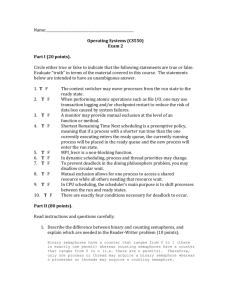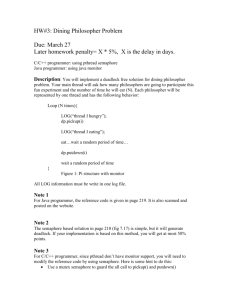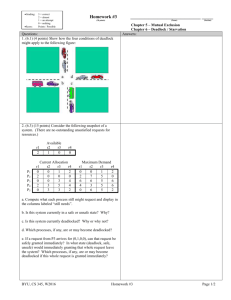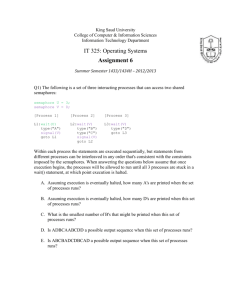CH 06 -Deadlock
advertisement
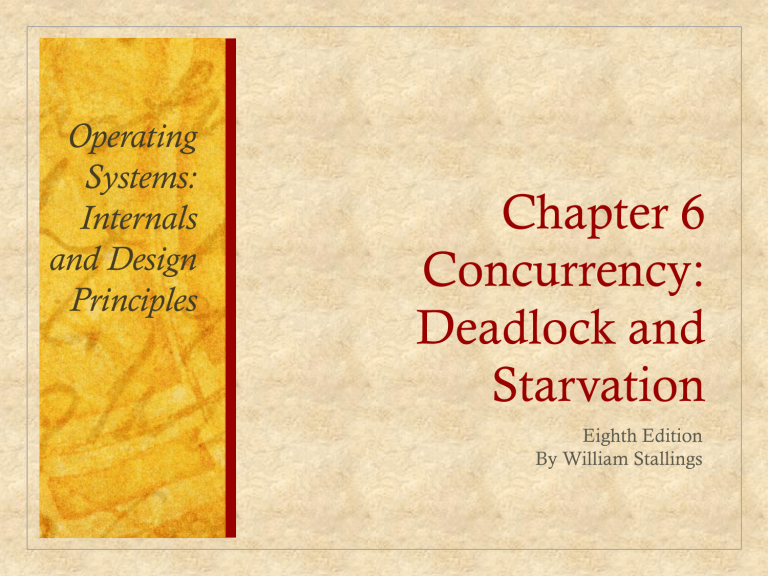
Operating
Systems:
Internals
and Design
Principles
Chapter 6
Concurrency:
Deadlock and
Starvation
Eighth Edition
By William Stallings
The permanent blocking of a set of processes that
either compete for system resources or
communicate with each other
A set of processes is deadlocked when each
process in the set is blocked awaiting an event
that can only be triggered by another blocked
process in the set
Permanent
No efficient solution
A situation in which a single runnable process is
repeatedly denied its request for a resource (CPU, data
structure, …) and the resource is given to another
process.
Starvation does NOT involve a circular wait
Starvation doesn’t take resources out of the system (to
the blocked state)
Indefinite in length
Sometimes caused by priority resource allocation,
sometimes just by chance (e.g., Ethernet CSMA/CD)
3
4
c
b
d
a
2
3
2
4
1
1
(a) Deadlock possible
Figure 6.1 I llustration of Deadlock
(b) Deadlock
Reusable
• can be safely used by only one process at a time
and is not depleted by that use
• processors, I/O channels, main and secondary
memory, devices, and data structures such as
files, databases, and semaphores
Consumable
• one that can be created (produced) and
destroyed (consumed)
• interrupts, signals, messages, and
• Information in I/O buffers
Process P
Step
p0
p1
p2
p3
p4
p5
p6
Action
Request (D)
Lock (D)
Request (T)
Lock (T)
Perform function
Unlock (D)
Unlock (T)
Process Q
Step
q0
q1
q2
q3
q4
q5
q6
Action
Request (T)
Lock (T)
Request (D)
Lock (D)
Perform function
Unlock (T)
Unlock (D)
Figure 6.4
Example of Two Processes Competing for Reusable Resources
Example 2:
Memory Request
Space is available for allocation of 200Kbytes, and
the following sequence of events occur:
P1
...
...
Request 80 Kbytes;
Request 70 Kbytes;
Request 60 Kbytes;
Request 80 Kbytes;
...
P2
...
Deadlock occurs if both processes progress to their
second request
Consumable Resources
Deadlock
Consider a pair of processes, in which each process attempts to receive a
message from the other process and then send a message to the other
process:
Deadlock occurs if the Receive is blocking
Requests
Ra
P1
Held by
Ra
P1
(a) Resouce is requested
(b) Resource is held
Ra
Ra
He
ld
sts
ue
q
Re
P1
P2
He
ld
sts
ue
q
Re
by
He
ld
sts
ue
q
Re
by
by
P1
P2
He
ld
sts
ue
q
Re
by
Rb
Rb
(c) Circular wait
(d) No deadlock
Figure 6.5 Examples of Resource Allocation Graphs
R.A.G. for deadlocked intersection
P1
P2
P3
P4
Ra
Rb
Rc
Rd
3
4
c
b
d
a
2
3
2
4
1
1
(a) Deadlock possible
(b) Deadlock
Figure 6.1 I llustration of Deadlock
Figure 6.6 Resource Allocation Graph for Figure 6.1b
Conditions for Deadlock
Mutual
Exclusion
• only one
process may
use a
resource at a
time
Hold-andWait
• a process
may hold
allocated
resources
while
awaiting
assignment
of others
No Pre-emption
• no resource
can be
forcibly
removed
from a
process
holding it
• (doesn’t
apply to
CPU or
memory)
Circular Wait
• a closed
chain of
processes
exists, such
that each
process holds
at least one
resource
needed by
the next
process in
the chain
Dealing with Deadlock
Three general approaches exist for dealing with deadlock:
Prevent Deadlock
• adopt a policy that eliminates one of the conditions
Avoid Deadlock
• make the appropriate dynamic choices based on the
current state of resource allocation
Detect Deadlock
• attempt to detect the presence of deadlock and take
action to recover
Design a system in such a way that the possibility of deadlock is
excluded
Two main methods:
Indirect
prevent the occurrence of one of the three necessary conditions
Direct
prevent the occurrence of a circular wait
Mutual
Exclusion
if access to a
resource requires
mutual exclusion
then it must be
supported by the OS
Hold and Wait
require that a process
request all of its
required resources at
one time and block
the process until all
requests can be
granted
simultaneously
No Preemption
if a process holding certain resources is denied a further request, that
process must release its original resources and request them again
OS may preempt the second process and require it to release its
resources
Useful only if state of resource can be saved & restored
Circular Wait
define a linear ordering of resource types and force processes to
request resources in order. In other words, if you have been granted
resource i and then request resource j, j must be greater than i.
A decision is made dynamically whether the current
resource allocation request will, if granted, potentially
lead to a deadlock
Requires knowledge of future process requests
Deadlock
Avoidance
Resource
Allocation Denial
Process Initiation
Denial
• do not grant an
incremental resource
request to a process if
this allocation might
lead to deadlock
• do not start a
process if its
demands might lead
to deadlock
Referred to as the banker’s algorithm
State of the system reflects the current allocation of
resources to processes
Safe state is one in which there is at least one sequence of
resource allocations to processes that does not result in a
deadlock
Unsafe state is a state that is not safe; i.e., it
cannot be proved that deadlock is impossible.
Note that this doesn’t prove that deadlock will
happen, only that it is possible.
P1
P2
P3
R1
3
6
3
P4
4
R2
2
1
1
R3
2
3
4
2
2
Claim matrix C
P1
P2
P3
P4
R1
R2
R3
9
3
6
Resource vector R
R1
1
6
2
R2
0
1
1
R3
0
2
1
0
0
2
Allocation matrix A
P1
P2
P3
R1
2
0
1
R2
2
0
0
R3
2
1
3
P4
4
2
C–A
0
R1
R2
0
1
Available vector V
(a) I nitial state
Figure 6.7 Determination of a Safe State
R3
1
P1
P2
P3
R1
3
0
3
P4
4
R2
2
0
1
R3
2
0
4
2
2
Claim matrix C
P1
P2
P3
P4
R1
R2
R3
9
3
6
Resource vector R
R1
1
0
2
R2
0
0
1
R3
0
0
1
P1
P2
P3
0
0
2
Allocation matrix A
R1
P4
R2
R3
6
2
3
Available vector V
(b) P2 runs to completion
Figure 6.7 Determination of a Safe State
R1
2
R2
2
R3
2
0
1
0
0
0
3
4
2
C–A
0
P1
P2
P3
P4
R1
0
0
3
R2
0
0
1
R3
0
0
4
4
2
2
Claim matrix C
R1
P1
P2
P3
P4
R1
R2
R3
9
3
6
Resource vector R
0
0
2
R2
0
0
1
0
0
Allocation matrix A
R3
0
0
1
R1
P1
P2
P3
2
P4
0
1
R2
0
0
0
R3
0
0
3
4
2
0
0
C–A
R1
R2
7
2
Available vector V
(c) P1 runs to completion
Figure 6.7 Determination of a Safe State
R3
3
P1
P2
P3
R1
0
0
0
P4
4
R2
0
0
0
R3
0
0
0
2
2
Claim matrix C
P1
P2
P3
P4
R1
R2
R3
9
3
6
Resource vector R
(d) P3 runs to completion
R1
0
0
0
R2
0
0
0
R3
0
0
0
R1
P1
P2
P3
0
0
2
Allocation matrix A
P4
0
0
0
4
C–A
R1
R2
9
3
Available vector V
(d) P3 runs to completion
Figure 6.7 Determination of a Safe State
R3
4
R2
0
0
0
2
R3
0
0
0
0
R1
R2
R3
P1
3
2
2
P1
P2
6
1
3
P2
P3
3
1
4
P3
P4
4
2
2
P4
R1
R2
R3
1
0
0
P1
1
1
P2
2
1
1
0
0
2
5
Claim matrix C
R1
R2
R3
2
2
1
0
2
P3
1
0
3
P4
4
2
0
R2
R3
2
1
2
C–A
Allocation matrix A
R1
R2
R3
9
3
6
R1
R2
R3
1
2
1
Resource vector R
Available vector V
(a) I nitial state
R1
R2
R3
R1
R2
R3
P1
3
2
2
P1
0
1
P1
P2
6
1
3
P2
5
1
1
P2
1
0
2
P3
3
1
4
P3
2
1
1
P3
1
0
3
P4
4
2
2
P4
0
0
2
P4
4
2
0
2
Claim matrix C
R1
1
C–A
Allocation matrix A
R1
R2
R3
R1
R2
R3
9
3
6
0
1
1
Resource vector R
Available vector V
(b) P1 requests one unit each of R1 and R3
Figure 6.8 Determination of an Unsafe State
Figure 6.8 Determination of an Unsafe State
It is less restrictive than deadlock prevention
It is not necessary to preempt and rollback processes, as in
deadlock detection
• Maximum resource requirement for each process
must be stated in advance
• Processes under consideration must be independent
and with no synchronization requirements
• There must be a fixed number of resources to allocate
• No process may exit while holding resources
Deadlock Strategies
Deadlock prevention & avoidance
strategies are very conservative
• limit access to resources by imposing restrictions on
processes
Deadlock detection strategies do the
opposite
• resource requests are granted whenever possible
Deadline Detection
Algorithms
Advantages:
A check for deadlock can
be made as frequently as
each resource request or,
less frequently, depending
on how likely it is for a
deadlock to occur
• it leads to early
detection
• the algorithm is
relatively simple
Disadvantage
• frequent checks
consume
considerable
processor time
R1 R2 R3 R4 R5
R1 R2
R3 R4 R5
P1
0
1
0
0
1
P1
1
0
1
1
0
P2
0
0
1
0
1
P2
1
1
0
0
0
P3
0
0
0
0
1
P3
0
0
0
1
0
P4
1
0
1
0
1
P4
0
0
0
0
0
Request matrix
Q
Allocation
matrix A
R1
R2
R3
R4
R5
2
1
1
2
1
Resource vector
R1
R2
R3
R4
R5
0
0
0
0
1
Allocation vector
Figure 6.10 Example for Deadlock Detection
Recovery Strategies
Abort all deadlocked processes
Back up each deadlocked process to some
previously defined checkpoint and restart all
processes
Successively abort deadlocked processes until
deadlock no longer exists
Successively preempt resources until deadlock no
longer exists
Approach
Resource Allocation
Policy
Different Schemes
M ajor Advantages
M ajor
Disadvantages
•Inefficient
•Works well for
•Delays process
initiation
processes
that
perform
a
Requesting all resources at
single burst of activity
•Future resource
once
requirements must
•No preemption
necessary
be known by
processes
Prevention
Conservative;
undercommits
resources
Preemption
•Convenient when
applied to resources
whose state can be
saved and restored
easily
•Preempts more
often than necessary
Resource ordering
•Feasible to enforce via
compile-time checks
•Needs no run-time
computation since
problem is solved in
system design
•Disallows
incremental
resource requests
Avoidance
Midway between that
of detection and
prevention
Manipulate to find at least
one safe path
•No preemption
necessary
Detection
Very liberal;
requested resources
are granted where
possible
Invoke periodically to test
for deadlock
•Never delays process
initiation
•Facilitates online
handling
•Future resource
requirements must
be known by OS
•Processes can be
blocked for long
periods
•Inherent preemption
losses
Table 6.1
Summary of
Deadlock
Detection,
Prevention, and
Avoidance
Approaches for
Operating
Systems
[ISLO80]
An Integrated Deadlock
Strategy
• Group resources into classes.
• Use linear ordering to prevent deadlock
between classes
• Use appropriate method for each class
An Integrated Deadlock
Strategy
• Possible classes:
– Swap space (blocks of disk memory used for
swapping processes)
– Process resources: assignable devices; e.g. tape
drives & files
– Main memory: assigned in blocks to processes
– Internal resources: e.g., I/O channels
An Integrated Deadlock
Strategy
• Swap space
– Deny hold-and-wait by assigning all space at once
– Use avoidance if space required not known.
• Process resources
– Avoidance is reasonable (e.g., declare all files required in
advance).
– Resource ordering also possible
• Main memory: assigned in blocks to processes
• Internal resources: e.g., I/O channels
An Integrated Deadlock
Strategy
• Main memory:
– Preemption. Swap all or part of process out to
disk
• Internal resources: e.g., I/O channels
– Resource ordering
Dining Philosophers Problem
No two
philosophers can
use the same
fork at the same
time (mutual
exclusion)
No philosopher
must starve to
death (avoid
deadlock and
starvation)
P2
P1
P3
P4
P0
Figure 6.11 Dining Arrangement for Philosophers
/ * pr ogr am
diningphilosophers */
semaphor e fork [5] = {1};
i nt i;
voi d philosopher (int i)
{
whi l e ( t r ue) {
think();
wait (fork[i]);
wait (fork [(i+1) mod 5]);
eat();
signal(fork [(i+1) mod 5]);
signal(fork[i]);
}
}
voi d mai n( )
{
par begi n ( philosopher (0), philosopher (1), philosopher
(2),
philosopher (3), philosopher (4));
}
Figure 6.12
A First Solution to the Dining Philosophers Problem
/* pr ogr am diningphilosophers */
semaphor e fork[5] = {1};
semaphor e room = {4};
i nt i;
voi d philosopher (i nt i)
{
whi l e ( t r ue) {
think();
wait (room);
wait (fork[i]);
wait (fork [(i+1) mod 5]);
eat();
signal (fork [(i+1) mod 5]);
signal (fork[i]);
signal (room);
}
}
voi d mai n( )
{
par begi n ( philosopher (0), philosopher (1), philosopher (2),
philosopher (3), philosopher (4));
}
Figure 6.13 A Second Solution to the Dining Philosophers Problem
moni t or dining_controller;
cond ForkReady[5];
/* condition variable for synchronization */
bool ean fork[5] = {true};
/* availability status of each fork */
voi d get_forks(i nt pid)
/* pid is the philosopher id number
{
i nt left = pid;
i nt right = (++pid) % 5;
/*grant the left fork*/
i f (!fork[left])
cwait(ForkReady[left]);
/* queue on condition variable
fork[left] = false;
/*grant the right fork*/
i f (!fork[right])
cwait(ForkReady[right]);
/* queue on condition variable
fork[right] = false:
}
voi d release_forks(i nt pid)
{
i nt left = pid;
i nt right = (++pid) % 5;
/*release the left fork*/
i f (empty(ForkReady[left])
/*no one is waiting for this fork
fork[left] = true;
el se
/* awaken a process waiting on this fork
csignal(ForkReady[left]);
/*release the right fork*/
i f (empty(ForkReady[right])
/*no one is waiting for this fork
fork[right] = true;
el se
/* awaken a process waiting on this fork
csignal(ForkReady[right]);
}
*/
Figure 6.14
*/
*/
A Solution
to the
Dining
*/
*/
*/
Philosophers
Problem
*/
voi d philosopher[k=0 to 4]
/* the five philosopher clients */
{
whi l e (true) {
<think>;
get_forks(k);
/* client requests two forks via monitor */
<eat spaghetti>;
release_forks(k);
/* client releases forks via the monitor */
}
}
Using a
Monitor
UNIX Concurrency Mechanisms
UNIX provides a variety of mechanisms for interprocessor
communication and synchronization including:
Pipes
Messages
Semaphores
Shared
memory
Signals
Pipes
Circular buffers allowing two processes to
communicate on the producer-consumer model
first-in-first-out queue, written by one
process and read by another
Two types:
• Named
• Unnamed
Messages
A block of bytes with an accompanying type
UNIX provides msgsnd and msgrcv system calls for processes to
engage in message passing
Associated with each process is a message queue, which
functions like a mailbox
Typed messages
Read FIFO or by type
Block on empty queue
Shared Memory
Fastest form of interprocess communication
Common block of virtual memory shared by
multiple processes
Permission is read-only or read-write for a process
Mutual exclusion constraints are not part of the
shared-memory facility but must be provided by the
processes using the shared memory
Generalization of the semWait and semSignal
primitives
no other process may access the semaphore until all operations have
completed
Consists of:
• current value of the semaphore
• process ID of the last process to operate on the
semaphore
• number of processes waiting for the semaphore
value to be greater than its current value
• number of processes waiting for the semaphore
value to be zero
A software mechanism that informs a process of the occurrence of
asynchronous events
similar to a hardware interrupt, but does not employ priorities
A signal is delivered by updating a field in the process table for the process
to which the signal is being sent
A process may respond to a signal by:
performing some default action
executing a signal-handler function
ignoring the signal
Value
Name
Description
01
SIGHUP
Hang up; sent to process when kernel assumes that the
user of that process is doing no useful work
02
SIGINT
Interrupt
03
SIGQUIT
Quit; sent by user to induce halting of process and
production of core dump
04
SIGILL
Illegal instruction
05
SIGTRAP
Trace trap; triggers the execution of code for process
tracing
06
SIGIOT
IOT instruction
07
SIGEMT
EMT instruction
08
SIGFPE
Floating-point exception
09
SIGKILL
Kill; terminate process
10
SIGBUS
Bus error
11
SIGSEGV
Segmentation violation; process attempts to access
location outside its virtual address space
12
SIGSYS
Bad argument to system call
13
SIGPIPE
Write on a pipe that has no readers attached to it
14
SIGALRM
Alarm clock; issued when a process wishes to receive a
signal after a period of time
15
SIGTERM
Software termination
16
SIGUSR1
User-defined signal 1
17
SIGUSR2
User-defined signal 2
18
SIGCHLD
Death of a child
19
SIGPWR
Power failure
Table 6.2
UNIX Signals
(Table can be found on page 286 in textbook)
Linux Kernel
Concurrency Mechanism
Available to processes running in kernel mode; i.e., either kernel threads
or user processes that have made a system call.
Includes all the mechanisms found in UNIX plus:
Barriers
Spinlocks
Semaphores
Atomic
Operations
Atomic Operations
Atomic operations execute without interruption and
without interference – based on hardware instruction
when available
Simplest of the approaches to kernel synchronization
Integer
Bitmap
Two types:
Operations
Operations
operate on an
integer variable
typically used to
implement
counters
operate on one of
a sequence of bits
at an arbitrary
memory location
indicated by a
pointer variable
At omi c I nt eger Oper at i ons
ATOMIC_INIT (int i)
At declaration: initialize an atomic_t
to i
int atomic_read(atomic_t *v)
Read integer value of v
void atomic_set(atomic_t *v, int i)
Set the value of v to integer i
void atomic_add(int i, atomic_t *v)
Add i to v
void atomic_sub(int i, atomic_t *v)
Subtract i from v
void atomic_inc(atomic_t *v)
Add 1 to v
void atomic_dec(atomic_t *v)
Subtract 1 from v
int atomic_sub_and_test(int i, atomic_t
*v)
Subtract i from v; return 1 if the
result is zero; return 0 otherwise
int atomic_add_negative(int i, atomic_t
*v)
Add i to v; return 1 if the result is
negative; return 0 otherwise (used for
implementing semaphores)
int atomic_dec_and_test(atomic_t *v)
Subtract 1 from v; return 1 if the
result is zero; return 0 otherwise
int atomic_inc_and_test(atomic_t *v)
Add 1 to v; return 1 if the result is
zero; return 0 otherwise
At omi c Bi t map Oper at i ons
void set_bit(int nr, void *addr)
Set bit nr in the bitmap pointed to by
addr
void clear_bit(int nr, void *addr)
Clear bit nr in the bitmap pointed to
by addr
void change_bit(int nr, void *addr)
Invert bit nr in the bitmap pointed to
by addr
int test_and_set_bit(int nr, void *addr)
Set bit nr in the bitmap pointed to by
addr; return the old bit value
int test_and_clear_bit(int nr, void *addr)
Clear bit nr in the bitmap pointed to
by addr; return the old bit value
int test_and_change_bit(int nr, void
*addr)
Invert bit nr in the bitmap pointed to
by addr; return the old bit value
int test_bit(int nr, void *addr)
Return the value of bit nr in the
bitmap pointed to by addr
Table 6.3
Linux
Atomic
Operations
(Table can be found on page
287 in textbook)
Spinlocks
Most common technique for protecting a critical section in Linux
Can only be acquired by one thread at a time
any other thread will keep trying (spinning) until it can acquire the lock
Built on an integer location in memory that is checked by each thread
before it enters its critical section
Effective in situations where the wait time for acquiring a lock is
expected to be very short
Disadvantage:
locked-out threads continue to execute in a busy-waiting mode
void spin_lock(spinlock_t *lock)
Acquires the specified lock,
spinning if needed until it is
available
void spin_lock_irq(spinlock_t *lock)
Like spin_lock, but also disables
interrupts on the local processor
void spin_lock_irqsave(spinlock_t *lock,
unsigned long flags)
Like spin_lock_irq, but also
saves the current interrupt state
in flags
void spin_lock_bh(spinlock_t *lock)
Like spin_lock, but also disables
the execution of all bottom
halves
void spin_unlock(spinlock_t *lock)
Releases given lock
void spin_unlock_irq(spinlock_t *lock)
Releases given lock and enables
local interrupts
void spin_unlock_irqrestore(spinlock_t
*lock, unsigned long flags)
Releases given lock and restores
local interrupts to given
previous state
void spin_unlock_bh(spinlock_t *lock)
Releases given lock and enables
bottom halves
void spin_lock_init(spinlock_t *lock)
Initializes given spinlock
int spin_trylock(spinlock_t *lock)
Tries to acquire specified lock;
returns nonzero if lock is
currently held and zero otherwise
int spin_is_locked(spinlock_t *lock)
Returns nonzero if lock is
currently held and zero otherwise
Table 6.4
Linux Spinlocks
Semaphores
User level:
Linux provides a semaphore interface corresponding to that in
UNIX SVR4
Internally:
implemented as functions within the kernel and are more efficient
than user-visable semaphores
Three types of kernel semaphores:
binary semaphores
counting semaphores
reader-writer semaphores
Tr adi t i onal Semaphor es
void sema_init(struct semaphore
*sem, int count)
Initializes the dynamically created
semaphore to the given count
void init_MUTEX(struct semaphore
*sem)
Initializes the dynamically created
semaphore with a count of 1 (initially
unlocked)
void init_MUTEX_LOCKED(struct
semaphore *sem)
Initializes the dynamically created
semaphore with a count of 0 (initially
locked)
void down(struct semaphore *sem)
Attempts to acquire the given semaphore,
entering uninterruptible sleep if
semaphore is unavailable
int down_interruptible(struct
semaphore *sem)
Attempts to acquire the given semaphore,
entering interruptible sleep if semaphore
is unavailable; returns -EINTR value if a
signal other than the result of an up
operation is received
int down_trylock(struct semaphore
*sem)
Attempts to acquire the given semaphore,
and returns a nonzero value if semaphore
is unavailable
void up(struct semaphore *sem)
Releases the given semaphore
Reader - Wr i t er Semaphor es
void init_rwsem(struct
rw_semaphore, *rwsem)
Initializes the dynamically created
semaphore with a count of 1
void down_read(struct rw_semaphore,
*rwsem)
Down operation for readers
void up_read(struct rw_semaphore,
*rwsem)
Up operation for readers
void down_write(struct
rw_semaphore, *rwsem)
Down operation for writers
void up_write(struct rw_semaphore,
*rwsem)
Up operation for writers
Table 6.5
Linux
Semaphore
s
Table 6.6
Linux Memory Barrier Operations
rmb()
Prevents loads from being reordered across the barrier
wmb()
Prevents stores from being reordered across the barrier
mb()
Prevents loads and stores from being reordered across the
barrier
Barrier()
Prevents the compiler from reordering loads or stores
across the barrier
smp_rmb()
On SMP, provides a rmb() and on UP provides a barrier()
smp_wmb()
On SMP, provides a wmb() and on UP provides a barrier()
smp_mb()
On SMP, provides a mb() and on UP provides a barrier()
SMP = symmetric multiprocessor
UP = uniprocessor
Synchronization Primitives
Mutual
exclusion
(mutex)
locks
Condition
variables
Semaphores
In addition to the
concurrency
mechanisms of
UNIX SVR4,
Solaris supports
four thread
synchronization
primitives:
Readers/writer
locks
owner (3 octets)
lock (1 octet)
Type (1 octet)
wlock (1 octet)
waiters (2 octets)
waiters (2 octets)
union (4 octets)
type specific info (4 octets)
(statistic pointer or
number of write requests)
(possibly a turnstile id,
lock type filler,
or statistics pointer)
thread owner (4 octets)
(a) M UTEX lock
(c) Reader/writer lock
Type (1 octet)
wlock (1 octet)
waiters (2 octets)
waiters (2 octets)
count (4 octets)
(d) Condition variable
(b) Semaphore
Figure 6.15 Solaris Synchr onization Data Structur es
Used to ensure only one thread at a time can access the resource
protected by the mutex
The thread that locks the mutex must be the one that unlocks it
A thread attempts to acquire a mutex lock by executing the
mutex_enter primitive
Default blocking policy is a spinlock
An interrupt-based blocking mechanism is optional
Semaphores
Solaris provides classic counting
semaphores with the following primitives:
• sema_p() Decrements the semaphore,
potentially blocking the thread
• sema_v() Increments the semaphore,
potentially unblocking a waiting thread
• sema_tryp() Decrements the
semaphore if blocking is not required
Readers/Writer Locks
Allows
multiple threads to have simultaneous
read-only access to an object protected by the
lock
Allows
a single thread to access the object for
writing at one time, while excluding all readers
when lock is acquired for writing it takes on the status of
write lock
if one or more readers have acquired the lock its status is
read lock
A condition variable
is used to wait until
a particular
condition is true
Condition variables
must be used in
conjunction with a
mutex lock
Windows 7 Concurrency
Mechanisms
Windows provides synchronization among threads as part of the object
architecture
Most important methods are:
•
•
•
•
•
executive dispatcher objects
user mode critical sections
slim reader-writer locks
condition variables
lock-free operations
Wait Functions
Allow a
thread to
block its
own
execution
Do not
return
until the
specified
criteria
have been
met
The type
of wait
function
determines
the set of
criteria
used
Object Type
Definition
Set to Signaled State
When
Effect on Waiting
Threads
An announcement that a
system event has
occurred
Thread sets the event
All released
An announcement that a
Synchronization
system event has
event
occurred.
Thread sets the event
One thread released
Notification
event
Table 6.7
A mechanism that
provides mutual
exclusion capabilities;
equivalent to a binary
semaphore
Owning thread or other
thread releases the
mutex
One thread released
Semaphore
A counter that regulates
the number of threads
that can use a resource
Semaphore count drops
to zero
All released
Waitable timer
A counter that records
the passage of time
Set time arrives or time
interval expires
All released
File
An instance of an
I/O operation completes
opened file or I/O device
All released
Process
A program invocation,
including the address
space and resources
required to run the
program
Last thread terminates
All released
Thread
An executable entity
within a process
Thread terminates
All released
Mutex
Windows
Synchronization
Note: Shaded rows correspond to objects that exist for the sole purpose of synchronization.
Objects
Similar mechanism to mutex except that critical sections can be
used only by the threads of a single process
If the system is a multiprocessor, the code will attempt to acquire
a spin-lock
as a last resort, if the spinlock cannot be acquired, a dispatcher
object is used to block the thread so that the kernel can
dispatch another thread onto the processor
Slim Read-Writer Locks
Windows Vista added a user mode reader-writer
The reader-writer lock enters the kernel to block only after
attempting to use a spin-lock
It is slim in the sense that it normally only requires allocation of
a single pointer-sized piece of memory
Windows
also has condition variables
The
process must declare and initialize a
CONDITION_VARIABLE
Used
with either critical sections or SRW locks
Used
as follows:
1.
2.
3.
4.
acquire exclusive lock
while (predicate()==FALSE)SleepConditionVariable()
perform the protected operation
release the lock
Lock-free Synchronization
Windows also relies heavily on interlocked operations for
synchronization
interlocked operations use hardware facilities to guarantee that
memory locations can be read, modified, and written in a single
atomic operation
“Lock-free”
• synchronizing without taking a software lock
• a thread can never be switched away from a
processor while still holding a lock
Android adds to the kernel a new capability known as Binder
Binder provides a lightweight remote procedure call (RPC) capability
that is efficient in terms of both memory and processing requirements
also used to mediate all interaction between two processes
The RPC mechanism works between two processes on the same
system but running on different virtual machines
The method used for communicating with the Binder is the ioctl
system call
the ioctl call is a general-purpose system call for device-specific I/O
operations
Client
Binder
driver
Proxy
1
2
Stub
Service
3
4
5
6
7
8
Process A
Kernel
Process B
Figure 6.16 Binder Operation
Principles of deadlock
Reusable/consumable resources
Resource allocation graphs
Conditions for deadlock
Deadlock prevention
Mutual exclusion
Hold and wait
No preemption
Circular wait
Deadlock avoidance
Process initiation denial
Resource allocation denial
Deadlock detection
Deadlock detection algorithm
Recovery
Android interprocess communication
UNIX concurrency mechanisms
Pipes
Messages
Shared memory
Semaphores
Signals
Linux kernel concurrency mechanisms
Atomic operations
Spinlocks
Semaphores
Barriers
Solaris thread synchronization primitives
Mutual exclusion lock
Semaphores
Readers/writer lock
Condition variables
Windows 7 concurrency mechanisms


